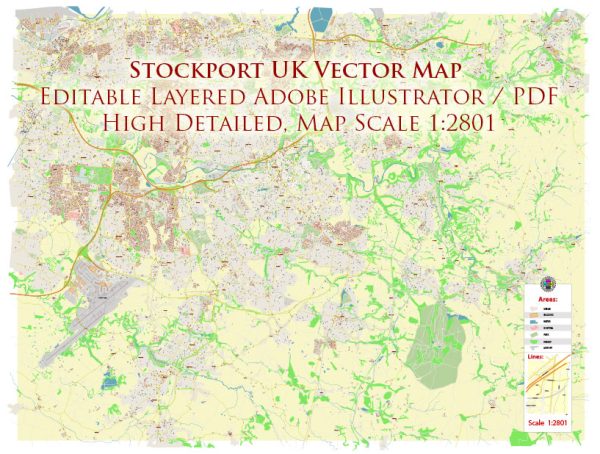Stockport, located in Greater Manchester, United Kingdom, has a rich history of urban development that spans centuries. The town’s evolution is marked by key historical events and changes in its economic, social, and architectural landscape.
- Early History: Stockport’s history dates back to at least the medieval period. The town’s name is believed to derive from the Old English words “stoc” (meaning a market) and “port” (a place with a market). The strategic location on the River Mersey made Stockport an important crossing point.
- Industrial Revolution: Like many towns in the North of England, Stockport experienced significant growth during the Industrial Revolution. The textile industry, particularly cotton and silk, became a major economic driver. Mills and factories were established along the rivers, transforming Stockport into an industrial hub.
- Transportation: The advent of the canal and later the railway in the 18th and 19th centuries played a crucial role in Stockport’s development. The town became a transportation hub, facilitating the movement of goods and people. The viaduct, completed in 1840, is a notable architectural landmark that reflects this period.
- Urban Expansion: As industries expanded, so did the town. Residential areas developed around the factories, and the population grew. The Victorian era saw the construction of many distinctive buildings, reflecting the prosperity of the time.
- Market Town: Stockport has a long history as a market town, and its market remains a focal point. The market tradition dates back to at least the 13th century, and the market square continues to be a vibrant center for commerce and community activities.
- Post-World War II: Like many industrial towns, Stockport faced challenges in the post-World War II period. Deindustrialization and changes in the economic landscape led to shifts in the town’s character. Urban planning initiatives and redevelopment projects aimed to adapt to these changes.
- Modern Development: In recent decades, Stockport has undergone further regeneration efforts to modernize its infrastructure and attract new businesses. The town center has seen redevelopment projects, and efforts have been made to preserve and repurpose historic buildings.
- Cultural and Recreational Spaces: Stockport has invested in cultural and recreational facilities, such as museums, theaters, and parks, to enhance the quality of life for residents and attract visitors.
- Housing and Architecture: The housing landscape in Stockport reflects various architectural styles from different periods. From historic cottages to Victorian terraces and modern developments, the town’s architecture is diverse.
- Challenges and Opportunities: Like many urban areas, Stockport faces ongoing challenges, including balancing development with conservation, addressing transportation needs, and fostering economic growth while preserving its historical identity.
To delve deeper into Stockport’s history of urban development, local archives, historical societies, and museums would be valuable resources. They can provide more detailed information and may showcase artifacts and documents that offer a closer look at the town’s past.


 Author: Kirill Shrayber, Ph.D.
Author: Kirill Shrayber, Ph.D.